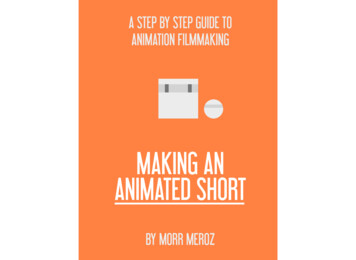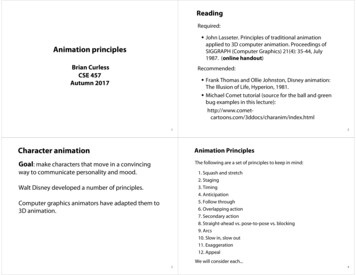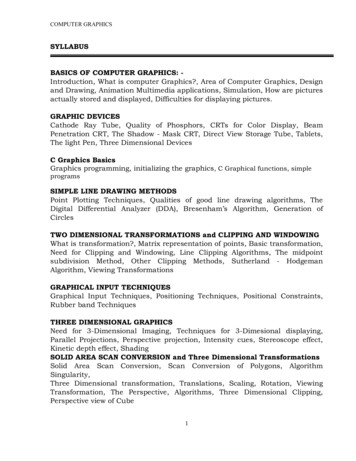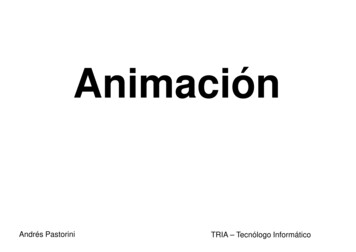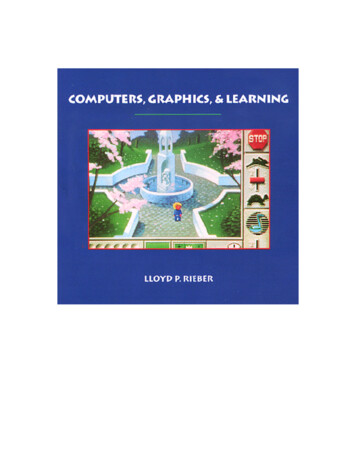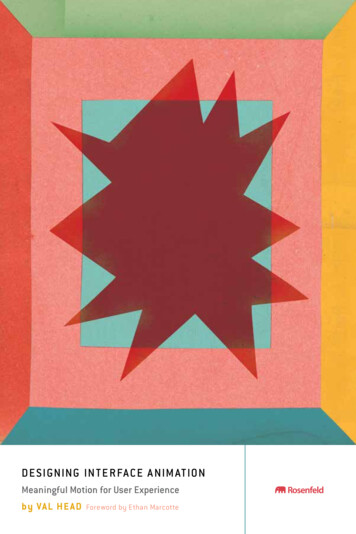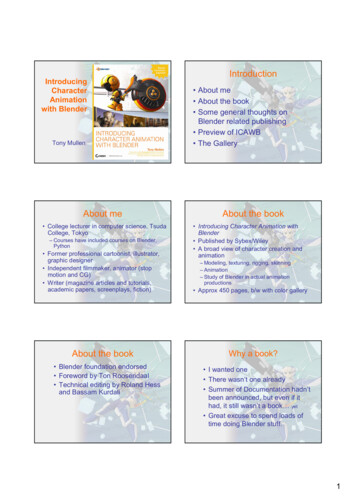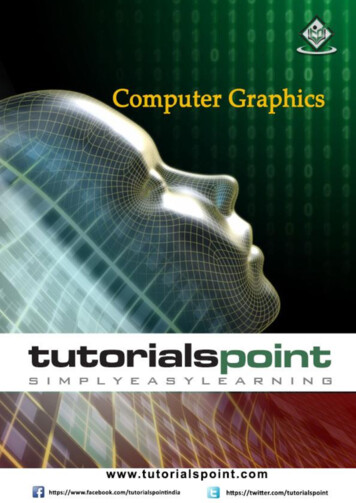
Transcription
Computer GraphicsComputerGraphics & AnimationComputer animation is the use of computers to create animations. There are a fewdifferent ways to make computer animations. One is 3D animation. One way to createcomputer animations is to create objects and then render them. This method producesperfect and three dimensional looking animations. Another way to create computeranimation is to use standard computer painting tools and to paint single frames andcomposite them. These can later be either saved as a movie file or output to video.One last method of making computer animations is to use transitions and other specialeffects like morphing to modify existing images and video.Computer graphics are any types of images created using any kind of computer. Thereis a vast amount of types of images a computer can create. Also, there are just as manyways of creating those images. Images created by computers can be very simple, suchas lines and circles, or extremly complex such as fractals and complicated renderedanimations.If you want to create your own computer graphics, no matter how simple or complex,you have to know a few things about computers, computer graphics, and how theywork.The following information should help you get started in the field of computergraphics: Anti-aliasing Keyframe Modeling Morphing & Warping Mesh Object orientedgraphicsBinary systemBit AAST/ComputerAnimation/CompAn Graphix.html (1 of 3) [30/05/2001 11:53:43 PM]
Computer Graphics Boolean operations Onionskinning Contouring Pixel Coordinate System Primitives Digitizing Real time rendering Dithering Rendering Face Resolution File types Surface Mapping Fractals Transitions Hierarchy Vertex Inverse KinematicsMember of the Internet Link ExchangeEvolutionGraphics AST/ComputerAnimation/CompAn Graphix.html (2 of 3) [30/05/2001 11:53:43 PM]
Computer GraphicsCompanies &AssociationsFilesOther Sites Help-n-TipsCreated by Krys Cybulski & David ion/CompAn Graphix.html (3 of 3) [30/05/2001 11:53:43 PM]
Graphics DefinitionsRenderingRendering is the process a computer uses to create an image from a data file. Most 3Dgraphics programs are not capable of drawing the whole scene on the run with all thecolors, textures, lights, and shading. Instead, the user handles a mesh which is a roughrepresentation of an objects. When the user is satisfied with the mesh, he then rendersthe image.A MeshA Rendered ImageWire FrameThis isn't really a rendering method, by definition. Most 3D graphics programsrepresent objects as meshes. What happens in wire frame rendering is, every section ofthe mseh gets colored in with the average color of the texture. This comes in usefullfor special effects, and for quick previews. To take wire frame rendering one stepfurther, some programs do a process called hidden line removal. It is just like normalwire frame rendering, except the parts of the mesh that would not be visible if aph Rendering.html (1 of 6) [30/05/2001 11:54:11 PM]
Graphics Definitionsmesh was a solid are not rendered.Rendering usually takes a long time. The time it takes to render an image depends onthe quality of rendering. There are a couple of different qualities of rendering.Flat ShadingThe quickest rendering method. Some programs are able to render flat shaded objectsin real time. When rendering using flat shading, the computer takes creates an averagecolor for an object and then renders each face with different amounts of black or whiteadded to simulate shading. Objects look flat and unrealistic. No textures are applied inthis ation/Graph Rendering.html (2 of 6) [30/05/2001 11:54:11 PM]
Graphics DefinitionsGourad rendering takes flat rendering one step further. The computer figures outvalues of a color on vertices of a face and then applies a gradient to the face tosimulate shading. This mode is not much slower than flat shading and can also berendered in real time on some of the more powerfull computers.PhongPhong rendering takes rendering yet one more step further. It actualy probes everypixel in the visible area and tries to determine a correct color for it. It takes intoaccount all lights and textures. This is often as good as many low-end programsrender. The results are pretty good, and the time that it takes to render is not imation/Graph Rendering.html (3 of 6) [30/05/2001 11:54:11 PM]
Graphics DefinitionsRay TracingThe best rendering quality. It also takes very long, but the results are awesome.Everything is rendered, including shadows, lighting, reflections, and transparancies. Italso does another thing that other rendering options don't. It gives light a physicalattribute. For example, a rendering of a pencil in a glass of water would give you thesame diffraction effect that nature does: the pencil will appear broken. When acomputer ray traces an image, it simulates a beam of light going out of every pixel onthe screen. It reflects and deflects the beam of light in a similar fashion nature would.Finally it takes outcome of all this and puts it on the screen.Here is a link to a more "in depth" definition of ray tracing at SIGGraph.Look at this site dedicated to ray erAnimation/Graph Rendering.html (4 of 6) [30/05/2001 11:54:11 PM]
Graphics DefinitionsThere is a new method of rendering that was recently developed. It is called radiosity.It does something all the other rendering methods don't do: it figures out therelationship in the scene of all the objects present. For example, in real life, if you takea bright colored ball and put it into a white room, the walls of the room are going toreflect a little bit of color from the ball, making them look a little reddish for example.This is not possible in raytracing, since it does not bounce rays off of matte objects,such as a wall.You can compare the above picture to the one of the raytraced object. Allthough this isnot a very good example, you can see that the checkecrboar pattern of the "tri-ball"has a slight effect on the color of the bricks right underneath it. This adds the extrathing to rendered scenes and makes them look extremely realistic.Radiosity produces extremly good results, but unfortunatly, there is a tradeoff:rendering time. Before the computer even starts rendering, it has to solve a certain"radiosity model" which is the relationship of one object on all the other ones in ascene. Then it can start rendering.For some more information on radiostiy,try this site out at Cornell.For some sample images of raytracing and radiosity try this image sampler, again atCornell.Here are some links to some extra informations as well as in depth explanations ofterms that have to do with rendering:Color TheoryIlluminationColor and LightDiffuse ReflectionSpecular tion/Graph Rendering.html (5 of 6) [30/05/2001 11:54:11 PM]
Graphics DefinitionsReflection & TransparencyShading TechniquesBack to GRAPHICS.EvolutionGraphics &AnimationCompanies &AssociationsFilesToolsApplicationsOther Sites Help-n-TipsCreated by Krys Cybulski & David ion/Graph Rendering.html (6 of 6) [30/05/2001 11:54:11 PM]
Graphics DefinitionsTransitionIn computer animation, transitions are ways of moving from one picture to another. Asimple transition might be a fade. In a fade, one image fades out while the other onefades in giving an animation a cool look. Other examples of transitions are wiping,morphing, blending, etc.Back to GRAPHICS.EvolutionGraphics &AnimationCompanies &AssociationsFilesToolsApplicationsOther Sites Help-n-TipsCreated by Krys Cybulski & David ion/Graph Transition.html [30/05/2001 11:54:14 PM]
Graphics DefinitionsMorphingMorphing is a very cool looking transition. It is also one of the most complicated ones.A morph looks as if two images melt into each other with a very fluid motion. Intechnical terms what happens is, two images are distorted and a fade occurs betweenthem. This is pretty complicated to understand, but belive me, it looks very cool. (Youmight have seen morphing in the Gillette and Shell gasoline comercials).Warping is the same as morhping, except only one image is distorted and no fadeoccurs.The original graphics A warped version of this imageIf you have Netscape 2.0 or another browser that supports animated GIF's, wait for thebelow image to load to see a warping Mona Lisa.Back to ion/Graph Morphing.html (1 of 2) [30/05/2001 11:54:44 PM]
Graphics DefinitionsEvolutionGraphics &AnimationCompanies &AssociationsFilesToolsApplicationsOther Sites Help-n-TipsCreated by Krys Cybulski & David ion/Graph Morphing.html (2 of 2) [30/05/2001 11:54:44 PM]
Graphics DefinitionsFractalsFractals are very complex pictures generated by a computer from a single formula.Very often they are very colorful and look beautiful. A fractal gets created by usingiterations. This means that one formula is repeated with slightly different values overand over again, taking into acount the results from the previous iteration. The resultsare then graphed. In fractals, the little parts of them look like the big picture, and whenone zooms in more, one will find more and more repeating copies of the original.For more information on fractals, try the fractal FAQ.Back to GRAPHICS.EvolutionGraphics &AnimationCompanies &AssociationsFilesToolsApplicationsOther Sites ation/Graph Fractals.html (1 of 2) [30/05/2001 11:55:01 PM]
Graphics DefinitionsCreated by Krys Cybulski & David ion/Graph Fractals.html (2 of 2) [30/05/2001 11:55:01 PM]
Graphics DefinitionsAnti-aliasingAnti-aliasing is the process of bluring sharp edges in pictures to get rid of the jaggededges on lines. After an image is rendered, some applications automatically anti-aliasimages. The program looks for edges in an image, and then blurs adjacent pixels toproduce a smoother edge.In order to anti-alias an image when rendering, the computer has to take samplessmaller than a pixel in order to figure out exactly where to blur and where not to. Forexample, if the computer finds that one pixel is on the edge of thwo objects, it thentakes sub-pixel samples and checks about how many of them showed the fron obejct,and how many showed the back one. Lets say that the computer took 8 sub-samples,and 4 of them were on object one and the other 4 on object two. The computer thentakes the resulting color values from the subsamples and averages them into aresulting blurred pixel, when viewed from a distance gives a smoother edge effect.In the below example, you can see an image without anti-aliasing and withanti-aliasing and enlargements of these two pictures.Original imageAnti-aliased imageOriginal image (x6)Anti-aliased image (x6)A more detailed description of anti-aliasing as well as the explanation of differentalgorithms used is available bye following this link at SIGGraph.Back to ion/Graph AntiAlias.html (1 of 2) [30/05/2001 11:55:08 PM]
Graphics DefinitionsEvolutionGraphics &AnimationCompanies &AssociationsFilesToolsApplicationsOther Sites Help-n-TipsCreated by Krys Cybulski & David ion/Graph AntiAlias.html (2 of 2) [30/05/2001 11:55:08 PM]
Graphics DefinitionsBinary SystemEverything in the computer world, including graphics, is based on the binary system.The binary system is based on only 2 numbers, 0 and 1, unlike our decimal systemwhich is based on numbers from 0 through 9. You can also think of the binary systembeing based on powers of 2 as the decimal system being based on powers of 10. Thisis because in the binary system you add another number place every time you reachanother power of two (2,4,8,etc) and in the decimal you add another place every timeyou reach a power of 10 (10,100,1000).The binary system is the simplest number system, since it only has two numbers.Computers use the binary system because binary information is extremely easy tostore. A system of ON and OFF switches will do the job. Every 0 is marked by anOFF switch, and every 1 is marked by an ON switch. Binary digits are also verysimple to work with mathematically, in fact, the computer can only do calculations onbinary digits. Every time you calculate something on a computer using our standarddecimal system, the computer converts it to binary, solves it, and converts it back todecimal and spits back out the answer.One might think that the binary system is very complicated, but it is not. When youcount in the decimal systems it goes like this: 0, 1, 2, 3, 4, 5, 6, 7, 8, 9 and then youran out of digits, so you make a two-digit number, 10. In the decimal system it isexactly the same: 0, 1, and you are already out of digits. Now you make the binarynumber 10, which is equivalent to the decimal 2. And then you go on: 10, 11, 100,101, and so on.Here is a table of the first 20 binary numbers and their decimal 00011001010011Back to ion/Graph BinarySystem.html (1 of 2) [30/05/2001 11:55:12 PM]
Graphics DefinitionsEvolutionGraphics &AnimationCompanies &AssociationsFilesToolsApplicationsOther Sites Help-n-TipsCreated by Krys Cybulski & David ion/Graph BinarySystem.html (2 of 2) [30/05/2001 11:55:12 PM]
Graphics DefinitionsBit DepthBit depth is the number of bits used to store information about each pixel. The higher the depth, the more colors arestored in an image. For example, the lowest bit-depth, 1 bit graphics are only capable of showing two colors, black &white. This is because there are only two combinations of numbers in one bit, 0 and 1. Four bit color is capable ofdisplaying 16 colors because there are 16 different combinations of four bits:0000 0001 0010 0011 0100 0101 0110 0111 1000 1001 1010 1011 1100 1101 1110 1111With 8 bit color, there is a total of 256 colors available. With 16 bit color, a total of 65536 is available. When you have24 bit color, a total of 16777216 colors is available.Bit depth might refer to the bit depth of an image, or the bit depth of a monitor. When it refers to the bit depth of amonitor, it means that your monitor is able to show a certain number of colors at one time. If it is meant as the bit depthof an image, it means that the image may contain the specified number of colors.The following are examples of the same image of different bit-depths. You might not be able to appreciate all the qualityof 16 bit images if your monitors do not support those bit-depths.1-Bit image 8-Bit image 16-Bit image(781 bytes) (5,362 bytes) (11,982 bytes)You might wonder why not use the best bit depth for all images to make them look good. Well, as you might havenoticed, the higher the bit depth, the more bits per pixel used in an image, and the more pixels used in an image, thelarger the actual file is going to be. Sometimes you don't need very high image quality, so you won't use a high bit depthto preserve space.Back to GRAPHICS.EvolutionGraphics &AnimationCompanies &AssociationsFilesToolsApplicationsOther Sites Help-n-TipsCreated by Krys Cybulski & David ion/Graph BitDepth.html [30/05/2001 11:55:23 PM]
Graphics DefinitionsBitmapA bitmap is a collection of pixels that describes an image, in human terms, a complete picture. Abitmap can be of various bit depth and resolution. Basicly, a bitmap is an array of pixels.A bitmapped graphic Enlarged to show detail and individual pixels.Back to GRAPHICS.EvolutionGraphics &AnimationCompanies &AssociationsFilesToolsApplicationsOther Sites Help-n-TipsCreated by Krys Cybulski & David ion/Graph Bitmap.html [30/05/2001 11:55:32 PM]
Graphics DefinitionsBitmappedGraphicsThere are two kinds of computer graphics: Bit Mapped and Object Oriented. Bitmapped graphics are graphics that are stored in the form of a bitmap. They are asequence of bits that get drawn onto the screen. You create bit mapped graphics usinga painting program. You can not edit the components of a bitmapped image once youdrew them. For example, if you use your painting program to draw a line, you will notbe able to edit that line as a separate object. It becomes part of the image. From nowon, that line is a pattern of pixels.When you enlarge a bit mapped image, you will get a pixelated look. If you areplanning to print out an image that was originally 3 inches on 3 inches as 6 inches by 6inches, you will get a very pixelated look.One might use bit mapped graphics to edit digitized pictures. Bit mapped graphics areusually easier to work with. Bit mapped graphics tend to create larger files than objectoriented graphics. There are some exceptions to that rule.Original bitmapped graphic Same image scaled upAs you can see from these two pictures, when a bitmapped image gets scaled up, thedetail is lost, as opposed to an object oriented drawing where no pixelation occurs.Back to ion/Graph BitmapGraph.html (1 of 2) [30/05/2001 11:55:39 PM]
Graphics DefinitionsEvolutionGraphics &AnimationCompanies &AssociationsFilesToolsApplicationsOther Sites Help-n-TipsCreated by Krys Cybulski & David ion/Graph BitmapGraph.html (2 of 2) [30/05/2001 11:55:39 PM]
Graphics DefinitionsKeyframeWhen someone creates a 3D animation on a computer, they usually don't specify theexact position of any given object on every single frame. They create keyframes.Keyframes are important frames during which an object changes its size, direction,shape or other properties. The computer then figures out all the in between frames andsaves an extreme amount of time for the animator.2 frames drawn by userInbetween frames generated by computerFinal Animtion(Note: Actual in between frames were drawn by me,not the computer, so the animation is not very smooth,but I hope it does demonstrate the concept.)Back to GRAPHICS.EvolutionGraphics AST/ComputerAnimation/Graph Keyframe.html (1 of 2) [30/05/2001 11:55:46 PM]
Graphics DefinitionsCompanies &AssociationsFilesOther Sites Help-n-TipsCreated by Krys Cybulski & David ion/Graph Keyframe.html (2 of 2) [30/05/2001 11:55:46 PM]
Graphics DefinitionsModelingThere are many ways of creating meshes on a computer. In order to aquire a complexmesh, it can often be digitized. More often however, one has to model the mesh.Modeling is the process of creating 3D objects from simple 2D objects by lofting, orfrom other simple 3D objects called primitives. Primitves can be combined using avariety of boolean operations. They can also be distorted by dragging around theirvertices or distorted in different ways.Back to GRAPHICS.EvolutionGraphics &AnimationCompanies &AssociationsFilesToolsApplicationsOther Sites Help-n-TipsCreated by Krys Cybulski & David ion/Graph Modeling.html [30/05/2001 11:55:50 PM]
Graphics DefinitionsMeshA mesh is a collection of faces which describe an object. An object can be anything, asphere, a pyramid, a car tire, or an elaphant. The faces are arranged in such a way thatthey form the outside surface of that object. It could be thought of as the skin of theobject. The mesh is usually depicted in wireframe mode, as this shows the faces andthe outline and does not take very long to render.A very simple mesh of a sphereBack to GRAPHICS.EvolutionGraphics &AnimationCompanies &AssociationsFilesToolsApplicationsOther Sites ation/Graph Mesh.html (1 of 2) [30/05/2001 11:55:58 PM]
Graphics DefinitionsCreated by Krys Cybulski & David ion/Graph Mesh.html (2 of 2) [30/05/2001 11:55:58 PM]
Graphics DefinitionsObject OrientedGraphicsThere are two kinds of computer graphics: Bit Mapped and Object Oriented. You create object oriented graphics in adrawing program. When you create objects in a drawing program, you can still edit them after you have donesomething else. For example, if you draw a circle in one place, then draw a rectangle in another place, you can stillselect the circle and change its size and location. This is possible because object oriented graphics are stored asdimensions and formulas, unlike bit mapped graphics which are stored as individual pixels. When a drawingprogram opens a drawing file, it will look for objects, not pixels. A drawing file may be thought of as a series ofinstructions like the ones below, but in a computer language which most normal people can not understand.Draw a circle at the point that is 100 pixels to the right and 140 pixels downfrom the top-left corner of the screen with the radius of 25 pixels.There are advantages as well as disadvantages to object oriented graphics over bitmapped graphics. As alreadymentioned, object oriented graphics can still be modified as separate objects after being modified, unlike bitmappedwhich can't. Second, object oriented graphic files (drawing files) are usually much smaller in size than bitmappedgraphics. Third, you can enlarge a object oriented graphic to any size, and it will not loose detail. That is becausemost object oriented graphics are resolution-independant. A disadvantage is that there are usually harder to create,and can not have many interesting special effects done to them, such as bluring for example.Original object oriented imageSame image scaled upBack to GRAPHICS.EvolutionGraphics &AnimationCompanies &AssociationsFilesToolsApplicationsOther Sites Help-n-TipsCreated by Krys Cybulski & David ion/Graph ObjOrientGraph.html [30/05/2001 11:56:08 PM]
Graphics DefinitionsBooleanOperationsIn regard to 3D modeling, there are three primary operations: addition, subtraction,and intersection.In order to create a boolean object, you first need two other objects. They can beprimitves or other meshes. They also need to intersect in 3D space. If you do addition,the resulting object will be the sum of the two initial objects. It will look as if the twowere welded. If substration is what you are doing, the second object get subtractedfrom the first one. A hole in the shape of the second object is created in the first one.All the space that was occupied by both of the objects is taken away from the first one.Finally, in the intersecxtion mode, the final object occupies the area in which both ofthe intitial intersected.Two original objectsAdditionSubtractionIntersectionBack to ion/Graph Boolean.html (1 of 2) [30/05/2001 11:56:21 PM]
Graphics DefinitionsEvolutionGraphics &AnimationCompanies &AssociationsFilesToolsApplicationsOther Sites Help-n-TipsCreated by Krys Cybulski & David ion/Graph Boolean.html (2 of 2) [30/05/2001 11:56:21 PM]
Graphics DefinitionsContouringContouring is the loss of detail when converting a gradient image into a image with asmaller number of colors. An example is shown below.Original sphere The contouring effectBack to GRAPHICS.EvolutionGraphics &AnimationCompanies &AssociationsFilesToolsApplicationsOther Sites Help-n-TipsCreated by Krys Cybulski & David ion/Graph Contouring.html [30/05/2001 11:56:27 PM]
Graphics DefinitionsCoordinateSystemIn real life, we can tell where objects are by measuring distance between them. As forplacing them, moving them, and keeping track of where they are nature has developeda pretty good system. On the computer though, we have to somehow keep track ofobjects in a 3D scene. Mathematicians have developed the coordinate system. Youhave probably learned in geometry about the X and the Y axis. Well, these two axisdefine a coordinate plane, that is, a two dimentional world. However, to work in threedimentions, we need one more axis, the Z axis.Each axis is like a number line. The three axis are perpendicular to each other. Thepoint at which they intersect is called the point of origin. The point of origin isdesignated as 0,0,0, because it is located on the 0 point on all three axis. Now let's saythat you want to define a point in space. You can do this by giving three numbers. Thefirst one is the distance of the point from the origin in the X axis. The second one isthe offset of the point from the point of origin along the Y axis, and the third on thepoints distance away from 0 along the Z axis.3D Coordinate System2D Coordinate Plane (Imagine the Z axis perpendicularto the XY plane)Back to ion/Graph CoordinateSys.html (1 of 2) [30/05/2001 11:56:34 PM]
Graphics DefinitionsEvolutionGraphics &AnimationCompanies &AssociationsFilesToolsApplicationsOther Sites Help-n-TipsCreated by Krys Cybulski & David ion/Graph CoordinateSys.html (2 of 2) [30/05/2001 11:56:34 PM]
Graphics DefinitionsDigitizingDigitizing is the process of converting a continuos signal (such as sound or video) intodistinct units that the compute or other electronic equipment can process. There aremany ways to digitize things. there is the microphone, which digitizes sound. Thescanner can digitize photos and other images. A digital camera is able to bring videointo the computer.You can also digitize 3D objects. For that you use a 3D digitizer. These come in manydifferent shapes and sizes. They usually use lasers to map out the 3D points and createa mesh. Some other ones may use a pen as a probe which is attached to some sort ofarmature which can calculate points you touch on real objects into a computer model.Back to GRAPHICS.EvolutionGraphics &AnimationCompanies &AssociationsFilesToolsApplicationsOther Sites Help-n-TipsCreated by Krys Cybulski & David ion/Graph Digitizing.html [30/05/2001 11:56:37 PM]
Graphics DefinitionsDitheringDithering is the process of converting an image with a certain bit depth to one with alower bit depth. For example:Original imageDithered to 256 colorsWhen an application dithers an image, it converts colors that it can not display intopatterns of two or more colors that closely resemble the original. You can see that inthe B&W image. Patterns of different intensities of black and white pixels areconverted represent different shades of gray. Below are some more exaples:A gradient of graysSame gradient converted to B&WDithering works because your mind is tricked by the pattern of colors into thinkingthat it is a different color.Back to GRAPHICS.EvolutionGraphics AST/ComputerAnimation/Graph Dithering.html (1 of 2) [30/05/2001 11:56:47 PM]
Graphics DefinitionsCompanies &AssociationsFilesOther Sites Help-n-TipsCreated by Krys Cybulski & David ion/Graph Dithering.html (2 of 2) [30/05/2001 11:56:47 PM]
Graphics DefinitionsFaceA face is a collection of 3 or more verteces tied together to form a small trianglesurface. Most 3D programs use 3 sided faces, but some support 4 sided ones too. Acollection of faces is refered to as a mesh. Each face also has a special entity tied to itcalled a normal. The normal defines which side of the face is considered to be theinside of an object, and which is the outside.Faces are very often refered to as polygons.Each red triangle is a faceBack to GRAPHICS.EvolutionGraphics &AnimationCompanies &AssociationsFilesToolsApplicationsOther Sites ation/Graph Face.html (1 of 2) [30/05/2001 11:56:55 PM]
Graphics DefinitionsCreated by Krys Cybulski & David ion/Graph Face.html (2 of 2) [30/05/2001 11:56:55 PM]
Graphics DefinitionsTitleThere is a very large number of different file formats for images andmovies/animations. There is no way to mention all of them. Different file types havetheir own qualities. Some file types store compressed images, others can only holdfiles of a specific bit depth and resolution. Finally, there are those files that containinformation specific only to one application.The following is a list of most common file types and their characteristics.DOS or UNIX MaximumDescriptionextension Bit DepthGif.GIF8Universal graphic fileTarga.TGA32Universal graphic fileJPEG.JPG24Universal graphic filePictnone32Standard Macintosh graphics fileTIFF.TIF32Universal graphic fileFlic.FLI8Animation; Less than 640 by 480Flic.FLC24Animation; Larger or 640 by 480Quicktime Movienone24Mac or Windows Digitized MovieSGI.SGI24SGI image fileRGB.RGB24SGI image fileStandard Windows graphic fileBMP.BMP8(Uncompressed)Standard Windows graphic fileRLE.RLE8(Compressed)PCX.PCX8Paintbrush graphics fileFile TypeAlso check out the following lists of file types:Image File Types3D File TypesAnimation File TypesBack to ion/Graph FileTypes.html (1 of 2) [30/05/2001 11:56:59 PM]
Graphi
Computer animation is the use of computers to create animations. There are a few different ways to make computer animations. One is 3D animation. One way to create computer animations is to create objects and then render them. This method produces perfect and three dimen
